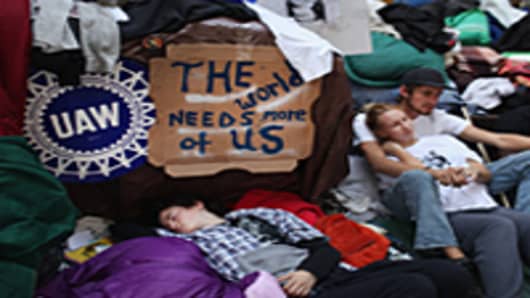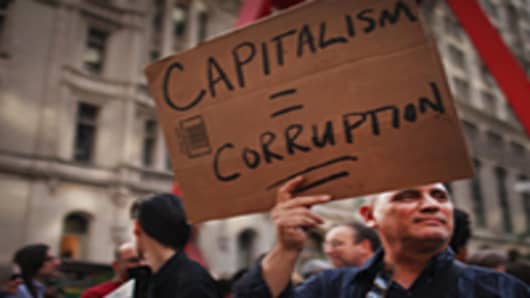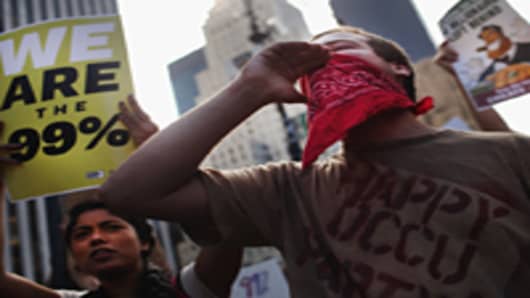It is a half-acre rectangle of gently sloping granite and concrete in lower Manhattan, just across the street from Ground Zero.
It is dotted with trees, a few beds of flowers and granite benches. And until recently, Zuccotti Park was a popular place for Wall Street workers to eat lunch.
Now it is home to the Occupy Wall Street encampment.
The protesters moved into Zuccotti Park on Sept. 17, after discovering that the original site where they planned to camp was closed. Ever since, there has been a group of protesters in the park day and night.
The population changes from day to day, and week to week. Some people come for a few days—perhaps a weekend—while others have been there for weeks. Long-timers like to brag about the length of their stay. Many more people visit during the day, then leave once the park settles down at night.
Some residents are hardcore political activists. Others are college students. Some are people who have found themselves in dire economic straits. Still others are punk rock kids who usually can be found in the East Village's Tompkins Square Park.
The Occupy Wall Street camp in Zuccotti Park has many of the features of a village, or even a household.
Various people in the park perform chores — cooking, cleaning, and ensuring that disputes are peacefully resolved — that we ordinarily associate with a municipality or a home. Because of this, the park is surprisingly clean and life there is surprisingly orderly, even after being occupied by protesters for four weeks.
Things are so well organized in the park that it is easy to imagine—if they are able to figure out a way to tough out the cold and snow of the coming winter—that Occupy Wall Street might last indefinitely.
A sanitation staff sweeps the walkways during the day, changes the bags in the garbage cans, and organizes recycling. They wear tape across their backs and chests reading “Sanitation.” And because the park is cleaned by fellow protesters, everyone in the park seems particularly mindful about keeping the place tidy.
“Littering isn’t even a question,” one protester told me. “You’d be shunned right out of here.”
A kitchen is set up near the center of the park. It serves three meals a day and takes in edible donations. The food is reportedly very tasty. The New York Times reportsthat it is so bountiful that some protesters are actually gaining weight during their stay in the park.
There’s a group dedicated to arts and culture that has been putting up art installations in the park. A makeshift library on the northeastern edge of the park lends out books. An archivist is busy collecting an oral history, as well as a sampling of the signs and pamphlets created as part of the protest.
Just a bit west of the library there is what appears to be the inner circle of Occupy Wall Street. Several people, many working on laptops powered by a portable generator, sit in an area closed off by tables.
Most people—including protesters—are kept out by beefy people whose blue arm bands mark them as members of the security group. Exactly what this secretive group is doing is not clear.
“They’re media relations, and outreach and planning,” one person said.
So why are outsiders being kept from the area? No one would answer.
And so, ironically, there’s a no trespassing policy enforced at Occupy Wall Street.
Each night the protesters convene on the western side of the park for what they call the general assembly.
Speakers from the various “working groups” talk about the day’s activities, plans for the future, and proposals for new policies. This is more or less the governing body of the protest. Very often, the meeting goes on for several hours.
Decisions are reached by consensus rather than a formal vote. A proposal—such as the policy banning drugs and alcohol use in the park—is made by a speaker. A call for dissent is made. If no on dissents, the policy is considered adopted by consensus. People on the ground signal their approval by raising their hands and wiggling their fingers. “Jazz Hands” is how some describe it.
On the far eastern end of the park, there usually is a half dozen or so people loudly playing the drums. Others dance to the music. One night a guy showed up with a trombone. The police have banned amplification, but are permitting these loud drum circle parties.
The meeting and the drumming usually wrap up around 10 p.m. local time, when the “quiet hours” in the park begin.
Late at night, the park is covered in sleeping bags, inflatable mattresses, and sleeping mats. Some protesters sleep under the stars, others pull tarps over themselves. It’s difficult to sleep outside — and most people seem to be getting three or four hours sleep, at most. On some nights, there are hundreds of people sleeping in the park.
When morning comes, protesters rise from their slumber, rolling up their mats and sleeping bags, and piling them up near trees.
Local businesses have been allowing protesters to use the bathrooms.
Apparently, some residents have even allowed protesters to use their showers.
One sign of the order and cleanliness of the park is the condition of the park's two flower beds. After four weeks amidst the protests, the multicolored flowers are thriving.
Ten years ago, Zuccotti Park was heavily damaged by the Sept. 11th attacks on the World Trade Center, which stood just across the street.
Immediately after 9/11, the park, then known as Liberty Park, was a staging area for rescue and recovery efforts. It was, for several years, little more than a barren strip of land, another scar on lower Manhattan’s landscape.
The park was rebuilt and reopened in 2006, with 55 trees planted and granite benches and tables installed. A 70-foot-tall sculpture — titled Joie de Vivre— of criss-crossing bright-red beams was installed in the southeast corner. An older bronze sculpture — a lifelike rendition of an office worker reading a newspaper — was restored and now sits in the northwest corner of the park.
The park is actually a privately owned public space, originally created by US Steel in return for permission to build its headquarters higher than zoning restrictions allowed. This status of private ownership with public access created a quirk in the law that made it particularly open to “occupation” by the Occupy Wall Streeters.
New York City parks are usually subject to closing hours, curfews after which police can remove anyone still in the park. But the private ownership of the park exempts Zuccotti Park from these rules.
In fact, the agreement that created the park requires it to remain open 24 hours a day.
Questions? Comments? Email us atNetNet@cnbc.com
Follow John on Twitter @ twitter.com/Carney
Follow NetNet on Twitter @ twitter.com/CNBCnetnet
Facebook us @ www.facebook.com/NetNetCNBC





